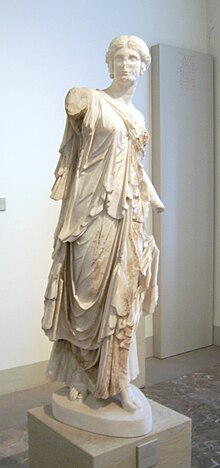Dancer from Pergamon
As a dancer one is Hellenistic girl statue of Pergamon referred to now in the Collection of Classical Antiquities Berlin is.
The so-called dancer was found in one of the two storage rooms of Palace V during the German excavations in Pergamon in March 1886 . The information on the circumstances of the find in the excavation diary speak in favor of the banquet room with the Hephaistion mosaic. It then came to the Berlin Antikensammlung (inventory no. AvP VII 43), where it was shown in the permanent exhibition in the Pergamon Museum until 2010 . In 2011/12 the statue made of white, transparent marble could be seen in the special exhibition Pergamon - Panorama of the ancient metropolis .
description
The young girl gives the impression of walking forward with her left leg forward. The body is slim and somewhat elongated. The right arm is raised. It was stated as a separately manufactured part and has not been preserved. The left arm is held down, the hand lightly gathers the robe. The hand and part of the forearm have been preserved, as have the statue base and feet, which have been replaced by a new creation made of artificial marble. The robe and face are partially damaged, the nose and several pieces of the folds of the robe are missing. The girl wears several wafer-thin, wet-looking robes, some of which are close to the body, some of which form deeply graded folds. The bottom layer is formed by a sleeve chiton with very fine folds, over which it wears a sleeveless additional garment. Its fine, trickling material is framed by a wide piping at the neck and shoulders . The top layer is the very fabric-rich coat, which falls in wide, deep folds. It starts from the right shoulder, leaves the left shoulder and the left breast free, and its design is reminiscent of the sloping cloaks of archaic Koren from the 6th century BC. The robes support the dynamism of the statue rather than concealing it. The creator of the statue played with different opposites, for example with the splayed stand on the one hand, with the bent knees and the torsion of the upper body on the other. The delineated forms of the archaic garment with its quilted folds and tight-fitting fabric sections on the legs are contrasted with a completely different materiality with the lush, voluminous coat that swings backwards. This game of opposites continues in the head and face. The face, with its swelling cheeks, deep-set eyes and small, full mouth, looks very soft, as does the wavy long hairstyle, in which the forehead and temple hair is held by a band. This is answered by rigid spiral curls in the neck and in front of the ears, which in their archaism act like a frame.
classification
The statue, which for stylistic reasons dates to the period between 150 and 125 BC. It is 120 centimeters high, 114 centimeters without the plinth , and the head 14.5 centimeters. The statue, which is smaller than life, is an example of the luxury of furnishings in the Pergamene palaces. The archaic representation is intentional, it reminds of the grace, the " charis " of the portrayed, moreover it was customary at this time to use archaic forms in the Dionysian framework - and the arrangement in the banquet room speaks for such. Due to the missing attributes, only a guess can be made about the use. Even Heinrich Bulle believed by comparing the woman with the lamp from the ship found in Mahdia and the find of a woman in Boscoreale to draw the conclusion that this is also a woman with a lamp holding a torch in her outstretched right arm. This view has largely prevailed, even if there are no parallels among the other archaic statues that have survived. The statue was already damaged in antiquity , either by the chaos of war or by earthquakes. That is why there are some curiosities in the design today. So the hair on the back of the neck is short on the left, on the side facing you. On the right side there is the typologically correct long spiral curl. It can be assumed that the left side in this form came about through a secondary, ancient processing.
literature
- Christiane Vorster : The "dancer" from Palace V in Pergamon. In: Rolf Grüßinger, Volker Kästner , Andreas Scholl (eds.): Pergamon. Panorama of the ancient metropolis. Book accompanying the exhibition. Michael Imhof Verlag, Petersberg 2011, ISBN 978-3-86568-693-0 , pp. 148-151 and pp. 508-509 (catalog).
Web links
- Internet catalog of the Berlin sculptures in the archaeological database Arachne
